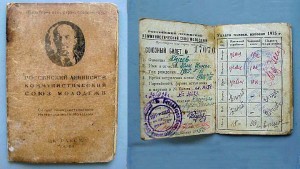Commiepolitan 2015-09-26 18:55:40
The beginning of the 20th century marked a huge change for Russian culture. Society began to step away from the old works of literary giants, such as Pushkin and Dostoevsky, and pushed toward a newer,[…]
Read moreThe beginning of the 20th century marked a huge change for Russian culture. Society began to step away from the old works of literary giants, such as Pushkin and Dostoevsky, and pushed toward a newer,[…]
Read moreFind: Morozova’s sister, Evdokia Urusova, who shared the fate of the Old Believers. A wanderer whose face bears similar features of the artist, Vasily Surikov. Blessing the crowd in the two-fingered manner of the Old[…]
Read moreMikhail Zoshchenko was an immensely popular Russian writer and satirist during the early soviet era. He used simple language to appeal to a broad base of Russian readers, who would have identified their grievances with the emerging and rapidly changing society with the humor and thematic undertones of Zoschenko’s work. In “The Lady Aristocrat”, published in a mass circulated newspaper,
Read moreLeon Trotsky, a influential Bolshevik and one of Lenin’s top lieutenants, foresaw the great power and influence that Cinema would have over popular culture. In a 1923 issue of the state controlled news magazine Pravda (“The Truth”) Trotsky detailed how the newly blooming cinematic industry would be a key tool of Bolshevik Soviet in the fight… More Kommunist Kino![]()
Vodka, the Church, and Cinema, are three ingredients to a revolutionary cocktail as well as the title of a piece written by Leon Trotsky. Trotsky was a Marxist theorist as well as a Revolutionary who lived in Russia during the early 20th century. As the Bolshevik Revolution simmered down, Trotsky was made into the commander […]
Read moreSocialist Cinema The cinema was really the only practical application of new life technology for the Soviets during the time of the revolution. New found technologies such as airplanes and cars were not something feasible for everyday use by the Soviets. During the revolution when the Bolsheviks were making films, they were not very well […]![]()

[Top show a Komsomol membership card with a picture of Lenin on the front; Bottom shows a Komsomol poster stating “Prepare for worthy successors to the Leninist Komsomol”] The Komsomol, also known as the Russian Communist Union of Youth, was an organization for young adults from the ages 14 to 28 that was established to teach and […]
Read more
In the 1920’s Russia was rapidly changing. The revolution was on, and not only was the government changing but also the way that people lived. Blue Blouse Skits were a change in the Russian theater that showed how living standards were changing. These plays were often preformed in the workplace to teach and inform the … Continue reading Lights of the Revolution →
Read moreBuzzer-Fly (1924) is a children’s story written by Kornei Chukovsky, Russia’s most famous children’s writer. Chukovsky created a fanciful tale of a fly on her birthday. The birthday fly invites her insect friends to celebrate her day. They enjoy a traditional Russian tea from a samovar. Unfortunately, their party comes to a sudden halt when a […]![]()

In 1919, playwright and revolutionary Pavel Arsky published his one-act play “For the Cause of the Red Soviets”. The play details one fateful evening in the lives of a family in which the father is a Soviet commander who is currently away from home, fighting in the civil war. It served as a serious piece […]
Read more